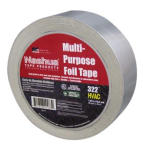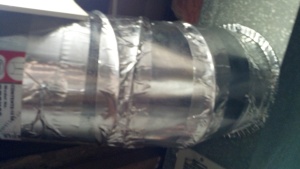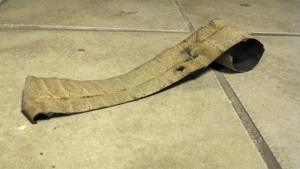When our friend, Richard, an HVAC professional, installed a new air duct in our new house a few weeks back he suggested we seal the leaks in our duct system.
“Feel this,” he said, putting his hand over a joint in a duct and waiting for me to do the same. I did so and felt a rather strong current of air. “Feel that air? Your system would be a lot more efficient if you sealed these with tape. You can do it yourselves with duct tape—that is why they originally called it duct tape—though you’ll need to replace it at some point, or you can use a metal tape like I’ll use to seal this vent I’m installing.” (paraphrase)
Aside from efficiently using energy, which is always important to me, I wanted comfortable, evenly heated and cooled rooms, a high priority to my temperature-sensitive self.
Of course, it always takes two people telling me to do something before I buy in.
Today that second “person” was Energy Star.
According to EnergyStar.gov, “Sealing and insulating ducts can improve the efficiency of your heating and cooling system by 20 percent or more. Accessible ducts, such as those in attics, basements, crawlspaces, and garages, can be sealed using a specialized sealant called duct mastic available at home improvement stores (duct tape is not recommended).”
The duct tape they’re referring to is the cloth-backed rubber adhesive duct tape of which we quickly think. Of course, I didn’t listen to that, either, and initially began sealing my ducts with duct tape until I found an old piece of duct tape, loosely hanging from a pipe, that illustrated why standard duct tape is a poor choice. (See my photo.) Ewe.
Duct Sealing: Do You Need To Do It, and How?
 So check out your air system (even you apartment dwellers). Turn on the air and put your hand in front of the metal joints. Do you feel air?
So check out your air system (even you apartment dwellers). Turn on the air and put your hand in front of the metal joints. Do you feel air?
If you do, go to your local home improvement store, pick up some aluminum foil tape (Nashua Multi-Purpose Aluminum Foil Tape 322 HVAC, $6.58 at HomeDepot.com). You can use mastic tape or mastic sealant instead, if you wish. We’re literally going to tape over the leaks to prevent air from blowing out of the system where it shouldn’t.
Next, clean the joints on which we’ll apply the tape with soap and water.
Begin sealing the air leaks by taping all the duct joints you can access. Even if it doesn’t feel like air is escaping doesn’t mean it won’t in the future, so tape around the duct in every place you can reach where two pieces of duct join.
Tape all joints on the furnace including the corners.
Finally, seal vents and registers where they meet floors, walls, and ceilings.
That’s it! It may not be perfect (less easily accessible leaks may still exist) but you’ll already enjoy a more efficient air system and, likely, more comfortable rooms.
Easy peasy.
Discussion:
What do you think? Have you sealed leaky ducts either yourself or by an HVAC professional?
What other easy energy efficiency projects have you done?





Posted by how to lose weight fast on January 30, 2014 at 3:06 am
You’ve made some really good points there. I looked on
the internet to find out more about the issue and found most individuals will go along with your views on this site.
Posted by Energy Audit & Efficient-izing My Home: TO DOs « The Whole LIFE on November 16, 2011 at 5:44 pm
[…] Seal the leaks in our HVAC duct system (okay, technically he didn’t suggest this because I knew it needed doing and so took care of this a week before he came by) […]
Posted by Gregory Waddoups on October 21, 2011 at 1:49 am
Right now it sounds like Expression Engine is the top blogging platform available right now. (from what I’ve read) Is that what you are using on your blog?
Posted by Clayton Warf on October 20, 2011 at 5:27 pm
Hello this is somewhat of off topic but I was wanting to know if blogs use WYSIWYG editors or if you have to manually code with HTML. I’m starting a blog soon but have no coding experience so I wanted to get guidance from someone with experience. Any help would be greatly appreciated!
Posted by Gonzalo on October 20, 2011 at 4:26 am
But a smiling visitor here to share the love (:, btw great pattern.
Posted by Jonelle Lonas on October 19, 2011 at 7:28 pm
Hi! I’ve been following your blog for a while now and finally got the bravery to go ahead and give you a shout out from New Caney Texas! Just wanted to say keep up the good work!
Posted by LadyL.I.F.E. on October 19, 2011 at 1:16 pm
There’s a link to the RSS feed in the top right next to the orange RSS feed logo; it says “RSS – Posts.” Thanks for commenting!
Posted by Canon on October 19, 2011 at 3:27 am
I love your blog, you should add an RSS feed feature so I can get automatic notifications of new blogs. If you set one up please email me! i will bookmark you for now. Again Excellent Blog!